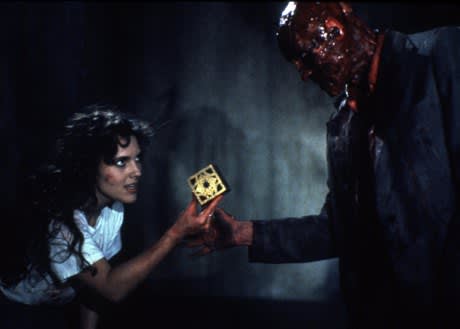Prurient in nature and thematic composition, Clive Barker's Hellraiser, a psychological examination of aberrant sexual desires in relation to socially imposed repression, makes a peculiar, even unlikely, entry into the populist horror franchise canon, playing out more as a gratuitous, subversive art film than a standard horror.
And where most stylized pretentious art-horror had taken a more surrealist approach to standard morality plays in decades prior, Hellraiser had an unpleasant and challenging focus in message, reading as both an analysis of sadomasochistic urges in subjugated people, forced by a dominant male hegemony to feel shame for sexual urges, as well as a metaphor for AIDS (being the late '80s and all).
This deviance from traditional sexual role assignment—as heightened by the repeated Judeo-Christian symbology peppered throughout the film—arises when married couple, Larry (Andrew Robinson) and Julia (Clare Higgins), move into an old family home where Larry's indulgent, hedonistic—and resultantly sexually adventurous—brother Frank (Sean Chapman) has been squatting. Quickly, we discover that Julia once had a sexually liberating and conversely degrading coital relationship with Frank that resulted in the standard intermingling of the pleasure and pain principle—arousal stemming from rejection and deviance—found in abused or repressed people.
How the monstrous element inserts itself into the storyline works in a superficial, visceral capacity, while maintaining artistic integrity by coming about right as Julia indulges in sexual fantasy as her husband gashes his hand carrying their bed up a flight of stairs. His blood brings about the bloodthirsty, exceedingly articulate, zombie of Frank, who eventually coerces Julia into bringing home stray men to feed to him.
Obviously, Zombie Frank is a metaphor for Julia's repressed desires, bringing about her initial nervousness and titillation by the prospect of doing something unseemly, like bringing home a stranger for deviant purposes. Of course, the presumed sex act interpretation is heightened and made melodramatic by her murdering her tricks—which, when mixed with the blood as lifeforce aspect of the film plays out as AIDS metaphor—while becoming increasingly comfortable with the act, resulting upping her game and willingness to experiment and denigrate herself. And, inevitably, this psychological game of sexual one-upmanship leads to the sadomasochistic, satanic—indulging in temptation—bitter end where pleasure and pain become interchangeable.
In itself, this astute and concise handling of morally abject sexual identity works as a profound and challenging narrative unto itself. But Barker's story—needing a climax (no pun intended)—shifts into a completely different gear in the third act, outlining the metaphoric sexual awakening of Larry's teen daughter Kirsty (Ashley Laurence), when she becomes aware of her parents' imperfections and distorted sexual identities.
While more viscerally appealing, involving spiked penis-monsters and an abundance of leather-clad S&M demons—one with overt vaginal imagery on its neck—this latter examination of blossoming—note the many flowers showing on screen when the penis-monster makes its appearance—female sexuality as garish mode of passive objectification is a little more glib and transparent. In discovering the horror of a sexually active world, Kirsty plays with a magical box (get it?) and opens a portal to the gates of hell, wherein women are subject to tearing and bleeding during the initial, penetrative sex act, which works as metaphor for life and death.
In presenting a teenage girl empowering and manipulating her box to ward off sexual oppressors, the cyclic nature of socially imposed female subjugation is complete. But it's odd that the break in narrative identification and thematic trajectory is so distinct between female protagonists as different stages of sexual awareness.
Still, this sort of work, while more congruent with queer theory than feminist theory, was a rarity for its time. And the fact that it became so successful in the populist lexicon—mostly because the viewers were preoccupied with the gore and inherent "coolness" of the incidental character, Pinhead—is a fascinating act of subversion on the part of Clive Barker. Though dated in visual effects and sheer aesthetics, this work is still a relevant and important cultural text, tackling sexuality in a sober manner that few films are even brave enough to acknowledge in passing.
Hellraiser screens at the TIFF Bell Lightbox as part of the Birth of a Villain retrospective at 10pm on Saturday, December 8th.
(New World)And where most stylized pretentious art-horror had taken a more surrealist approach to standard morality plays in decades prior, Hellraiser had an unpleasant and challenging focus in message, reading as both an analysis of sadomasochistic urges in subjugated people, forced by a dominant male hegemony to feel shame for sexual urges, as well as a metaphor for AIDS (being the late '80s and all).
This deviance from traditional sexual role assignment—as heightened by the repeated Judeo-Christian symbology peppered throughout the film—arises when married couple, Larry (Andrew Robinson) and Julia (Clare Higgins), move into an old family home where Larry's indulgent, hedonistic—and resultantly sexually adventurous—brother Frank (Sean Chapman) has been squatting. Quickly, we discover that Julia once had a sexually liberating and conversely degrading coital relationship with Frank that resulted in the standard intermingling of the pleasure and pain principle—arousal stemming from rejection and deviance—found in abused or repressed people.
How the monstrous element inserts itself into the storyline works in a superficial, visceral capacity, while maintaining artistic integrity by coming about right as Julia indulges in sexual fantasy as her husband gashes his hand carrying their bed up a flight of stairs. His blood brings about the bloodthirsty, exceedingly articulate, zombie of Frank, who eventually coerces Julia into bringing home stray men to feed to him.
Obviously, Zombie Frank is a metaphor for Julia's repressed desires, bringing about her initial nervousness and titillation by the prospect of doing something unseemly, like bringing home a stranger for deviant purposes. Of course, the presumed sex act interpretation is heightened and made melodramatic by her murdering her tricks—which, when mixed with the blood as lifeforce aspect of the film plays out as AIDS metaphor—while becoming increasingly comfortable with the act, resulting upping her game and willingness to experiment and denigrate herself. And, inevitably, this psychological game of sexual one-upmanship leads to the sadomasochistic, satanic—indulging in temptation—bitter end where pleasure and pain become interchangeable.
In itself, this astute and concise handling of morally abject sexual identity works as a profound and challenging narrative unto itself. But Barker's story—needing a climax (no pun intended)—shifts into a completely different gear in the third act, outlining the metaphoric sexual awakening of Larry's teen daughter Kirsty (Ashley Laurence), when she becomes aware of her parents' imperfections and distorted sexual identities.
While more viscerally appealing, involving spiked penis-monsters and an abundance of leather-clad S&M demons—one with overt vaginal imagery on its neck—this latter examination of blossoming—note the many flowers showing on screen when the penis-monster makes its appearance—female sexuality as garish mode of passive objectification is a little more glib and transparent. In discovering the horror of a sexually active world, Kirsty plays with a magical box (get it?) and opens a portal to the gates of hell, wherein women are subject to tearing and bleeding during the initial, penetrative sex act, which works as metaphor for life and death.
In presenting a teenage girl empowering and manipulating her box to ward off sexual oppressors, the cyclic nature of socially imposed female subjugation is complete. But it's odd that the break in narrative identification and thematic trajectory is so distinct between female protagonists as different stages of sexual awareness.
Still, this sort of work, while more congruent with queer theory than feminist theory, was a rarity for its time. And the fact that it became so successful in the populist lexicon—mostly because the viewers were preoccupied with the gore and inherent "coolness" of the incidental character, Pinhead—is a fascinating act of subversion on the part of Clive Barker. Though dated in visual effects and sheer aesthetics, this work is still a relevant and important cultural text, tackling sexuality in a sober manner that few films are even brave enough to acknowledge in passing.
Hellraiser screens at the TIFF Bell Lightbox as part of the Birth of a Villain retrospective at 10pm on Saturday, December 8th.




